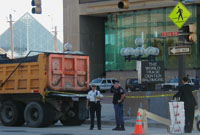| Maryland Newsline |
| Home Page |
Politics
|
| Governor Evacuates State
House, Declares State of Emergency
By Christopher Sherman
ANNAPOLIS - The historic State House was evacuated just after The threat -- that the State House, the World Trade Center in Baltimore By the time the State House was evacuated, a Maryland state of
The state of emergency reduced personnel at all state agencies to Maryland government continued from the State Emergency Operations Center The state of emergency declaration allows the governor to free state The Maryland National Guard's military police unit was federalized, The hospital ship, USS Comfort, docked in Baltimore, was sent to Norfolk,
Va.,
to stock medical supplies before heading to New York to participate in the About 100 people from the Montgomery County Urban Search and Rescue
unit joined three other search and rescue teams dispatched to the Pentagon. The Montgomery County members of the National Medical Response Team also Downtown Annapolis was ordered shut down by midday; the U.S. Naval Jammed phone lines were one indicator that people had more important "All of our networks on the East Coast are experiencing unprecedented call In Baltimore, the local FBI was mobilized, but at least one agent shared Tuesday afternoon, Calvert Cliffs nuclear power plant in Southern Maryland was at full power. "We've taken appropriate actions to ensure the continued safety of Calvert Cliffs nuclear power plant," said spokesman Karl Neddenien. Glendening was just arriving at the Renaissance Hotel in Baltimore to give Just before noon, as the governor was preparing for a television interview "It's both complex and confusing right now," the governor said, urging Glendening spoke with New York Gov. George Pataki
(R), Virginia Gov. Jim A spokeswoman said Glendening planned to spend the night at Government Shortly after 7 p.m. Tuesday, state police and FBI agents arrested Quentin Police said Johnson, who had briefly served in the military, called the Authorities took the call seriously at the time, but later tracked it to Officials said they do not know of a motive for the hoax. Johnson faces a CNS staff writers Carolyn Taschner
and Kristyn Peck contributed to this
report.
Copyright © 2001 University of Maryland College of
Journalism
|

